

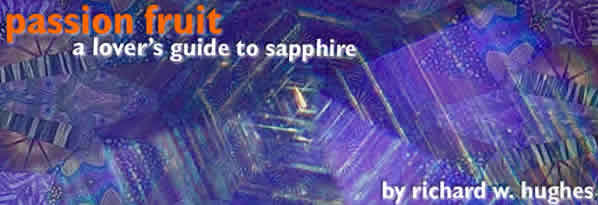
Editor’s Note: Continuing with our tradition of reproducing some of the nuggets from the literature of gems, we are proud to present this article from Palagems.com’s ex-webmaster, Richard Hughes. Hughes is author of Ruby & Sapphire, one of the finest books ever on a single gem species.
For additional information on sapphire, click the link below:
![]() Palagems.com Sapphire Buying Guide
Palagems.com Sapphire Buying Guide
© 2001 Richard W. Hughes
My love, she comes in colors.
— Arthur Lee, Love
The
business of judging precious stones is an eclectic one, not for
the timid or shameless. The appraisal of precious stones involves
decisions both conscious and unconscious. Try as we may to slice,
dice and pigeon-hole the elements of quality, in the end an analysis
of their features requires more than just a formula, just as
fine cooking involves not simply ingredients and a recipe. It
is about reaching for factors beyond the immediate senses, and
in that respect is quite like enjoyment of fine art, food and
music.
 While
one man’s Miles Davis might be another’s Kenny G, there
are certain things that the discerning among us look for. Thus, what
I will try to convey to you in the following passages is educated
emotion, something to help separate the long, languid lines of artistic
truth from aimless noodling. Here you will find the ingredients,
the recipe, the score. But without the passion that only the viewer
himself can bring, both these gems and our time on this precious
planet are a waste.
While
one man’s Miles Davis might be another’s Kenny G, there
are certain things that the discerning among us look for. Thus, what
I will try to convey to you in the following passages is educated
emotion, something to help separate the long, languid lines of artistic
truth from aimless noodling. Here you will find the ingredients,
the recipe, the score. But without the passion that only the viewer
himself can bring, both these gems and our time on this precious
planet are a waste.
 With
that introduction, let us now examine
blue sapphires. Here I have a confession
to make. Blue is my favorite color.
I love blue. Thus the following
essay is one of love.
With
that introduction, let us now examine
blue sapphires. Here I have a confession
to make. Blue is my favorite color.
I love blue. Thus the following
essay is one of love.
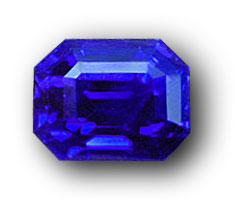 |
| This 4-ct. plus Kashmir sapphire sold by Pala International exhibits the velvety blue color that has made stones from this source without peer in the world. (Photo: John McLean; Gem: Pala International) |
Kashmir – Blue Velvet
This
fair dame is placed upon
a higher pedestal than all
others, only to have it ripped
out by every Tom, Dick and
Malagasy. First, let me let
you in on a base little secret.
The Kashmir mine has produced
jack-doodle since the 1930’s.
And the lion’s share
of production came out during
a half-breath period of just
seven short years – from
1881–1887.
 But
these were the halcyon days! If
one factors in the brief three-month
summer mining periods, within less
than thirty months, this tiny land
slip high in the Indian Himalaya
attained a reputation that has
left the world mumbling ever since
about having seen the light.
But
these were the halcyon days! If
one factors in the brief three-month
summer mining periods, within less
than thirty months, this tiny land
slip high in the Indian Himalaya
attained a reputation that has
left the world mumbling ever since
about having seen the light.
 What
is it about the Kashmir stone that
I find most attractive? I suppose
it is staying power. Plenty of
sapphires look magnificent under
one light, but when brought into
another, shed their beauty faster
than a K-Mart daisy. Not so for
these gems from the mighty Himalaya.
The finest Kashmir stones shine
the blue fantastic in all lights,
be it candles in that romantic
little downtown French bistro,
or beneath the garish fluorescents
in a suburban supermarket’s
meat department.
What
is it about the Kashmir stone that
I find most attractive? I suppose
it is staying power. Plenty of
sapphires look magnificent under
one light, but when brought into
another, shed their beauty faster
than a K-Mart daisy. Not so for
these gems from the mighty Himalaya.
The finest Kashmir stones shine
the blue fantastic in all lights,
be it candles in that romantic
little downtown French bistro,
or beneath the garish fluorescents
in a suburban supermarket’s
meat department.
 What
else do I like? I like their texture, that softness that envelopes
all like a sticky blue blanket, banishing darkness with that bluest
of blues. To get hypertechnical, we can call it a removal of extinction,
a scattering of light off the extremely fine silk, which is just
enough to exile the night, but not enough to materially affect
transparency. Note that here we have a direct contradiction of
the laws of diamond grading – here we have inclusions contributing
in a major way to the beauty of a gem.
What
else do I like? I like their texture, that softness that envelopes
all like a sticky blue blanket, banishing darkness with that bluest
of blues. To get hypertechnical, we can call it a removal of extinction,
a scattering of light off the extremely fine silk, which is just
enough to exile the night, but not enough to materially affect
transparency. Note that here we have a direct contradiction of
the laws of diamond grading – here we have inclusions contributing
in a major way to the beauty of a gem.
 And
what don’t I like? Do
you take me for a fool? A good
lover accepts the defects as
the price of admission. They
are nothing but the flaws in
a fine leather, a blown note
betwixt the sweet sheets of
a Coltrane sonic masterpiece.
And
what don’t I like? Do
you take me for a fool? A good
lover accepts the defects as
the price of admission. They
are nothing but the flaws in
a fine leather, a blown note
betwixt the sweet sheets of
a Coltrane sonic masterpiece.
Mogok – Round about midnight
Blue
midnight. The blue of the
finest Mogok stone is something
beyond vivid, beyond intense,
into a realm where blue,
black and lust intermingle.
But black is perhaps too
strong a word, for there
is nothing black about a
Mogok blue. To visualize
this, think of the color
of a desert sky about 15
minutes after the sun has
set, with stars rising in
the distance. This is the
color – an intense azure
hue matched in the world
of gems only by the finest
tanzanites (ten carats plus
here).
 Does
all of the Mogok stone display
this color? Of course not. There
are Mogok blues that entirely resemble
the lightest of Ceylon sapphires.
So understand that we are talking
about ideals here.
Does
all of the Mogok stone display
this color? Of course not. There
are Mogok blues that entirely resemble
the lightest of Ceylon sapphires.
So understand that we are talking
about ideals here.
 What
don’t I like? Cracks, fractures,
fissures, faults, label them as
you may, Many Mogok stones are
cursed by these destabilizing distractions.
Pox on cracks, and the horse they
rode in on.
What
don’t I like? Cracks, fractures,
fissures, faults, label them as
you may, Many Mogok stones are
cursed by these destabilizing distractions.
Pox on cracks, and the horse they
rode in on.
 What
else? Some Mogok blues are so very
intense that they suffocate. But
even these are still interesting
in the proper light. Oh, Mogok,
how I love you…let me count
the ways… sorry, I can’t,
there are just too many.
What
else? Some Mogok blues are so very
intense that they suffocate. But
even these are still interesting
in the proper light. Oh, Mogok,
how I love you…let me count
the ways… sorry, I can’t,
there are just too many.
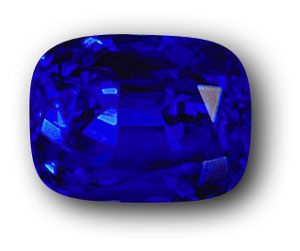 |
| 21.09 carats of Burmese midnight-blue mystery. This stone, an example of Mogok’s finest product, was offered in the late 1980s in Bangkok for $10,000/ct. wholesale. (Photo: Adisorn Studio, Bangkok) |
Ceylon – Snap
to it
Dame
Ceylon, what you have been through, how your fair name has been besmirched.
So many look down upon you. But fear not. The nay-sayers are nothing
but novices, those still waiting to have their minds blown by your
unique take on the blues. For when you are in your prime, you are
the equal of any. Let me say it again – the finest stones from
Serendib can blow with any blues on the bandstand.
 Top-shelf
Ceylon (today, Sri Lanka) sapphires
have something I will hereafter refer
to as “snap.” Like the
pointed slap of a stick against a
taut snare’s skin, the color
of certain Ceylon blues has an ocular
attack unlike any other in the sapphire
world. It slashes the eye like a
razor, similar to a cobaltian blue
of the finest Lanka spinels. Such
stones have that which makes “electric
blue” electric, and in the Island
of Gems are often compared to the
blue portion of a peacock’s
feather. Incidentally, this is also
true for gems from Kashmir, which
bear a far greater resemblance to
those from Ceylon than to Mogok blues.
Top-shelf
Ceylon (today, Sri Lanka) sapphires
have something I will hereafter refer
to as “snap.” Like the
pointed slap of a stick against a
taut snare’s skin, the color
of certain Ceylon blues has an ocular
attack unlike any other in the sapphire
world. It slashes the eye like a
razor, similar to a cobaltian blue
of the finest Lanka spinels. Such
stones have that which makes “electric
blue” electric, and in the Island
of Gems are often compared to the
blue portion of a peacock’s
feather. Incidentally, this is also
true for gems from Kashmir, which
bear a far greater resemblance to
those from Ceylon than to Mogok blues.
 Both
Sri Lankan and Kashmir stones suffer
from a tendency towards depth down
below. Due to the shape of the rough,
fashioning the biggest stones is
often an exercise in butt padding.
Zoning is also a problem. When you
are examining these gems, don’t
forget to rotate them through a full
360 degrees. This is, of course,
apropos in the evaluation of any
gem, but of utmost importance where
zoning is a problem. Pay particular
attention to areas where the color
might wash out.
Both
Sri Lankan and Kashmir stones suffer
from a tendency towards depth down
below. Due to the shape of the rough,
fashioning the biggest stones is
often an exercise in butt padding.
Zoning is also a problem. When you
are examining these gems, don’t
forget to rotate them through a full
360 degrees. This is, of course,
apropos in the evaluation of any
gem, but of utmost importance where
zoning is a problem. Pay particular
attention to areas where the color
might wash out.
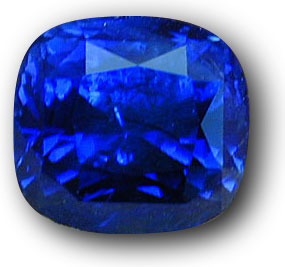 |
| This 7-ct.-plus untreated Ceylon sapphire currently available from Pala International is a perfect example of why origin should be a non-issue with fine gems. (Photo: John McLean; Gem: Pala International) |
The perfect sapphire
A fine gem has an unmistakable
sexual quality to it. This should come as no surprise. Both subjects
involve a good measure of passion. But the finest gems are like the
finest people. Their beauty grows with time.
 Some
sapphires drive you crazy the moment
their azure legs slither from a
stone paper, leaping onto the cocktail
table and saying: “Baby, let
me walk on your back with my high-healed
pumps!” These have a fast
rise time. But there is a difference
between love and lust, the subtle
versus animal desire. Each has
its moments. But in lovers, as
with gems, I look for staying power,
those which combine the cerebral
with the physical. For the physical
alone is not enough.
Some
sapphires drive you crazy the moment
their azure legs slither from a
stone paper, leaping onto the cocktail
table and saying: “Baby, let
me walk on your back with my high-healed
pumps!” These have a fast
rise time. But there is a difference
between love and lust, the subtle
versus animal desire. Each has
its moments. But in lovers, as
with gems, I look for staying power,
those which combine the cerebral
with the physical. For the physical
alone is not enough.
 The
beauty of love is its sublime,
understated nature. It offers you
a glass of wine and conversation,
before suggesting at the end of
the evening that the two of you
retire to the boudoir (just for
friendship, of course). In my experience,
such attraction is an emotion that
develops with time. Exceptional
gems grow on you. They are experts
at hiding, more interesting with
every listen, more exciting with
each glimpse. When you gaze at
their beauty for hours, days, weeks,
years on end without tiring you
know you have a fine gem. That,
my friends, is what I call love.
This takes distance, the kind that
only time provides.
The
beauty of love is its sublime,
understated nature. It offers you
a glass of wine and conversation,
before suggesting at the end of
the evening that the two of you
retire to the boudoir (just for
friendship, of course). In my experience,
such attraction is an emotion that
develops with time. Exceptional
gems grow on you. They are experts
at hiding, more interesting with
every listen, more exciting with
each glimpse. When you gaze at
their beauty for hours, days, weeks,
years on end without tiring you
know you have a fine gem. That,
my friends, is what I call love.
This takes distance, the kind that
only time provides.
 So
the next time you are taken aback
by a gem, stop yourself. You may
be looking at infatuation. Stand
back and judge. Take your time.
What you want is balance – Buddha’s
middle path – pure animal
sexuality and love – a
fashion model/pornstar lover who
left the business to pursue a dual
doctorate in physics and fine arts.
So
the next time you are taken aback
by a gem, stop yourself. You may
be looking at infatuation. Stand
back and judge. Take your time.
What you want is balance – Buddha’s
middle path – pure animal
sexuality and love – a
fashion model/pornstar lover who
left the business to pursue a dual
doctorate in physics and fine arts.
 And
just what, pray tell, would the
perfect sapphire look like? My
dear friends, that would be akin
to finding the perfect woman or
man. Leave D-Flawless to the gem
of the common man – it doesn’t
exist in sapphire. Don’t seek
perfection, just look for something
you can spend the rest of your
life with.
And
just what, pray tell, would the
perfect sapphire look like? My
dear friends, that would be akin
to finding the perfect woman or
man. Leave D-Flawless to the gem
of the common man – it doesn’t
exist in sapphire. Don’t seek
perfection, just look for something
you can spend the rest of your
life with.
Original sin
First, let me say that there is
a definite market ranking for sapphire according to origin. It unfolds
as follows:
That said, I would like to be allowed to burst
all your bubbles. Origin is not what’s important – quality
is.
 Permit
me to relate the following story.
A number of years ago, a pit
was discovered near Elahera on
the Island of Gems – Sri
Lanka. The stones from this mine
bore such a resemblance to those
of Kashmir that many labs actually
issued papers certifying Kashmir
as the source.
Permit
me to relate the following story.
A number of years ago, a pit
was discovered near Elahera on
the Island of Gems – Sri
Lanka. The stones from this mine
bore such a resemblance to those
of Kashmir that many labs actually
issued papers certifying Kashmir
as the source.
 In
light of the above, if the major
domo of a lab is not able to promise
you his/her first-born child in
trade when, at some later date,
he or she is proved wrong, then
do not accept the paper offered.
For what good is it?
In
light of the above, if the major
domo of a lab is not able to promise
you his/her first-born child in
trade when, at some later date,
he or she is proved wrong, then
do not accept the paper offered.
For what good is it?
 Back
in the good old days, origin was
based not on where a stone came
out of the ground, for there was
no sure way of proving the geography
of a stone, but on the appearance
of a stone relative to the typical
appearance of stones from certain
classic sources. Thus a Ceylon
sapphire that looked like a Kashmir
stone, became, de facto, a “Kashmir” sapphire
in the market. Similarly, the Mogok
stone that resembled a Ceylon,
became a Ceylon.
Back
in the good old days, origin was
based not on where a stone came
out of the ground, for there was
no sure way of proving the geography
of a stone, but on the appearance
of a stone relative to the typical
appearance of stones from certain
classic sources. Thus a Ceylon
sapphire that looked like a Kashmir
stone, became, de facto, a “Kashmir” sapphire
in the market. Similarly, the Mogok
stone that resembled a Ceylon,
became a Ceylon.
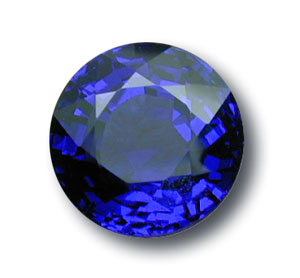 |
This
5-ct. plus untreated Burma sapphire currently available
from Pala International shows the intense violetish blue
color that has made Mogok sapphires among the most sought
after in the world. Its round shape makes it particularly
desirable. (Photo: John McLean; Gem: Pala International) |
 Sadly,
origin is today determined largely by invisible scientific criteria,
as opposed to obvious physical attributes. Rather than biting the
bullet and devising the means of judging aesthetic beauty (or admitting
that it is beyond reach), laboratories are today handing us the
ultimate silliness, a forehead-angle measurement of intelligence.
If asked to judge a Miss Universe pageant, such gemologists would
probably make the determination based on a DNA signature.
Sadly,
origin is today determined largely by invisible scientific criteria,
as opposed to obvious physical attributes. Rather than biting the
bullet and devising the means of judging aesthetic beauty (or admitting
that it is beyond reach), laboratories are today handing us the
ultimate silliness, a forehead-angle measurement of intelligence.
If asked to judge a Miss Universe pageant, such gemologists would
probably make the determination based on a DNA signature.
 But
what can I say? We are often
confronted with ridiculous
laws. In West Virginia, it
is legal to beat your wife
so long as it is done in public
on Sunday on the courthouse
steps, while in Denver, it
is against the law to lend
your neighbor a vacuum cleaner.
And lest we neglect our neighbors
to the north, in Canada it
is against the law to board
a plane while it’s in
flight. Yes, these are the
laws of the land – but
there are clearly cases that
call for a little civil disobedience.
Thus one may make use of origin
reports, but use them only
as a guide, not for a final
determination of the merits
of a fine gem. Dare to disagree
when common sense dictates
it. Don’t blindly trust
the machine. Personally examine
the ballots when necessary.
But
what can I say? We are often
confronted with ridiculous
laws. In West Virginia, it
is legal to beat your wife
so long as it is done in public
on Sunday on the courthouse
steps, while in Denver, it
is against the law to lend
your neighbor a vacuum cleaner.
And lest we neglect our neighbors
to the north, in Canada it
is against the law to board
a plane while it’s in
flight. Yes, these are the
laws of the land – but
there are clearly cases that
call for a little civil disobedience.
Thus one may make use of origin
reports, but use them only
as a guide, not for a final
determination of the merits
of a fine gem. Dare to disagree
when common sense dictates
it. Don’t blindly trust
the machine. Personally examine
the ballots when necessary.
Starry,
starry night
A
short time ago I had the
opportunity to view a particularly
fine sapphire. Its actual
origin, I will not say – for
that prejudice would simply
detract from its magnificent
beauty, manifest to all which
view gems with heart, rather
than microscope, in hand.
 Ilke
Bahn, our goldsmith at Pala International,
had just finished placing this
jewel in a handmade mounting. And
this mounting only served to enhance
the beauty of an already stunning
gem. Like the Vietnamese ao
di, a diaphanous garment one
observer described as “covering
everything but hiding nothing,” this
sapphire’s beauty shone to
greatest distraction. Ilke handed
the azure beauty to me to with
a gleam in her eye – the secret
of the night sky palmed to an innocent.
It was impossible to take my eyes
off it.
Ilke
Bahn, our goldsmith at Pala International,
had just finished placing this
jewel in a handmade mounting. And
this mounting only served to enhance
the beauty of an already stunning
gem. Like the Vietnamese ao
di, a diaphanous garment one
observer described as “covering
everything but hiding nothing,” this
sapphire’s beauty shone to
greatest distraction. Ilke handed
the azure beauty to me to with
a gleam in her eye – the secret
of the night sky palmed to an innocent.
It was impossible to take my eyes
off it.
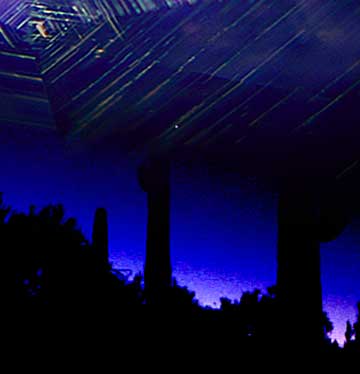 |
 I
will never forget a night several years ago when a close friend
and I were camped out in the desert at Joshua Tree. Sometime after
midnight, as we wandered the boulder-strewn stillness, our gaze
was drawn to the heavens. Stars carpeted the night from horizon
to shining horizon, the Milky Way cutting a swath through all of
everything – and nothing. As the night wore on and the sky
rotated, my consciousness shifted as well. I realized for the first
time my place on this spinning ball. The words of my friend still
echo – obvious, yes – but a truth that had eluded me
for so much of my life: “This is out here every night,” he
said. “All we need is to raise our eyes up above the horizon.”
I
will never forget a night several years ago when a close friend
and I were camped out in the desert at Joshua Tree. Sometime after
midnight, as we wandered the boulder-strewn stillness, our gaze
was drawn to the heavens. Stars carpeted the night from horizon
to shining horizon, the Milky Way cutting a swath through all of
everything – and nothing. As the night wore on and the sky
rotated, my consciousness shifted as well. I realized for the first
time my place on this spinning ball. The words of my friend still
echo – obvious, yes – but a truth that had eluded me
for so much of my life: “This is out here every night,” he
said. “All we need is to raise our eyes up above the horizon.”
 Up
above. So simple, so elegant.
And down below. I had a similar
experience while I gazed down
upon the ring Ilke had created.
As I squinted and peered, a silken
world spun by powers beyond my
imagination twinkled within – a
secret whispered just for me.
Here was such a special stone,
beautiful at all angles, from
above and below, at all and any
magnification.
Up
above. So simple, so elegant.
And down below. I had a similar
experience while I gazed down
upon the ring Ilke had created.
As I squinted and peered, a silken
world spun by powers beyond my
imagination twinkled within – a
secret whispered just for me.
Here was such a special stone,
beautiful at all angles, from
above and below, at all and any
magnification.
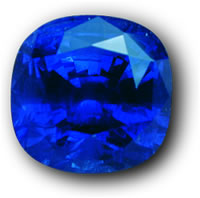 |
| This
7-ct. plus cushion recently sold by Pala International
is a beauty. Its origin? Madagascar. (Photo: John McLean; Gem: Pala International) |
 Call
it a signal from the Gods,
a voice from the heavens, an
eruption
from hell – epiphany – describe
it as you like. I put it thus:
at that instant in time, the
sun broke through the clouds,
the planets aligned. As I held
that sapphire ring in my hand,
I witnessed the birth of earth
and all creation. I gazed upon
Pangaea, saw the continents
form, then separate. Like that
starlit
sky in Joshua Tree, the true
majesty of mother nature struck
me. This sapphire was from
Madagascar.
Call
it a signal from the Gods,
a voice from the heavens, an
eruption
from hell – epiphany – describe
it as you like. I put it thus:
at that instant in time, the
sun broke through the clouds,
the planets aligned. As I held
that sapphire ring in my hand,
I witnessed the birth of earth
and all creation. I gazed upon
Pangaea, saw the continents
form, then separate. Like that
starlit
sky in Joshua Tree, the true
majesty of mother nature struck
me. This sapphire was from
Madagascar.
Coming home
If my readers take away anything
from these few lines of prose, I hope that it is that we should each
make use of our own eyes in judging gems. Read the law, listen to
the pros, but always rely on your own eyes. Let this be the lesson – buy
what looks good to you – dip your own spoon into the broth and
taste for yourself. Yes, let experts guide you, yes, buy quality,
but in the end, your own senses are the final arbitrator, not those
of the seller or of the labs. After all, it is you who will reap
the benefits of ownership of this wonderful sample of nature’s
beauty, not they. One of my first teachers explained it thus: An
exceptional gem is like an exceptional woman – they come in
all colors. Yes, indeed, my love, she comes in colors.
![]()
About the author. Richard Hughes is the author of the classic Ruby & Sapphire and can be reached at rubydick@ruby-sapphire.com or through his personal web site www.ruby-sapphire.com.
Author’s Afterword. Published in The Guide (2001, Vol. 20, No. 2, Part 1, March–April., pp. 3–5, 15).
![]()
|
Palagems.com
Blue Sapphire Buying Guide Introduction. The term sapphire alone describes the blue variety of gem corundum. Other colors have a color prefix, i.e., yellow sapphire, green sapphire, etc. The term ruby is reserved for corundums of a red color. In Asia, pink corundums are also considered rubies. Outside of Asia, such gems are generally termed pink sapphires. Color. For sapphire, the intensity of the blue color is the primary factor in determining value. The ideal stone displays an intense, rich blue without being dark or inky. Stones which are too dark and inky, or too light in color, are less highly valued. Lighting. Sapphires generally look best viewed with fluorescent light or daylight (particularly around just after sunrise and before sunset). Incandescent lights, whose output is tilted towards the red end of the spectrum, do not do most blue sapphires justice. Clarity. In
terms of clarity,
sapphires tend
to be cleaner
than ruby. Buyers
should look for
stones which
are eye-clean,
i.e., with no
inclusions visible
to the unaided
eye. In the case
of some sapphires,
extremely fine
silk throughout
the stone can
actually enhance
the value. This
is the case with
the famous sapphires
from Kashmir,
which display
a velvety blue
color with little
extinction across
the face. Cut. In the market, sapphires are found in a variety of shapes and cutting styles. Ovals and cushions are the most common, but rounds are also seen, as are other shapes, such as the heart or emerald cut. Slight premiums are paid for round stones. Cabochon-cut sapphires are also common. This cut is used for star stones, or those not clean enough to facet. The best cabochons are reasonably transparent, with nice smooth domes of good symmetry. Prices. Sapphire is one of the world’s most expensive gems, with prices similar to those fetched by fine ruby or emerald. But like all gem materials, low-quality (i.e., non-gem quality) pieces may be available for a few dollars per carat. Such stones are generally not clean enough to facet. The highest price ever paid for a blue sapphire was the 22.66-ct. unnamed Kashmir sapphire once owned by James J. Hill (the “Empire Builder”), which sold in 2007 for $135,216/ct. This sale barely topped the previous record: the 62.02-ct. Rockefeller sapphire, which sold in 2001 for $48,871/ct. Stone Sizes. Blue sapphires occur in far larger sizes than ruby, with Sri Lanka being the home of most of the faceted sapphires of quality in the 100-ct. plus range. Any untreated ruby of quality above two carats is a rare stone. Fine untreated rubies above five carats can be considered world-class pieces. Phenomena. Sapphire may display asterism, the star effect. Fine star sapphires display sharp six-rayed stars well-centered in the middle of the cabochon. All legs of the star should be intact and smooth. Just having a good star does not make a stone valuable. The best pieces have sharp stars against an intense blue body color. Lesser stones may have sharp stars, but the body color is too light or grayish. On occasion, 12-rayed star sapphires are found. Name. The name “sapphire” is believed to be derived from the Greek sappheiros, a word for blue. It is likely that the word sapphire was first applied to laps lazuli from Afghanistan. According to Oriental beliefs, sapphire is the gem of Saturn. It is also the birthstone for September. Sources. The original locality for sapphire was most likely Sri Lanka (Ceylon). Fine stones have also been found in Kashmir (India), Mogok (Burma), Madagascar, Thailand and Cambodia. Dark, inky blue sapphires come from Australia, China, Vietnam, Laos, Nigeria and a host of other localities. Fine blues of small size have been mined at Yogo Gulch, Montana (USA), while lesser stones have been produced elsewhere in Montana. Other sapphire localities include Kenya, Tanzania, Malawi and Rwanda. Enhancements. Today, the vast majority of blue sapphires are heat-treated to improve their appearance. The resulting stones are completely stable in color. In lower qualities, heat treated stones sell for roughly the same as untreated stones of the same quality. However, for finer qualities, untreated stones fetch a premium that is sometimes 50% or more when compared with treated stones of similar quality. Other treatments, such as oiling, dying and surface diffusion are seen on occasion. As with all precious stones, it is a good practice to have any major purchases tested by a reputable gem lab, such as the GIA or AGTA, to determine if a gem is enhanced. Imitations. Synthetic blue sapphires have been produced by the Verneuil process since about 1908 and cost just pennies per carat. Blue sapphire has also been produced by the flux, hydrothermal, floating zone and Czochralski processes, but such stones are rarely encountered. Doublets consisting of natural sapphire crowns and synthetic sapphire pavilions are fairly common, particularly in mining areas. Synthetics are also common at the mines, in both rough and cut forms. Lore. According to Indian astrological beliefs, sapphire is associated with the planet Saturn. Although the blue sapphire traditionally comes from Sri Lanka and Burma, it is rarely used in traditional Indian jewelry and Indian jewelers are sometimes reluctant to handle the stone associated with this powerful planet. Although no superstitions of this kind are associated with Islam, the gem was not commonly used even in the Mughal courts. No such fear exists in the West, an sapphire is one of the most popular of all gems. In the modern Western system, sapphire is the birthstone of September.
Properties of Blue Sapphire
For further information on sapphire, see also:
|